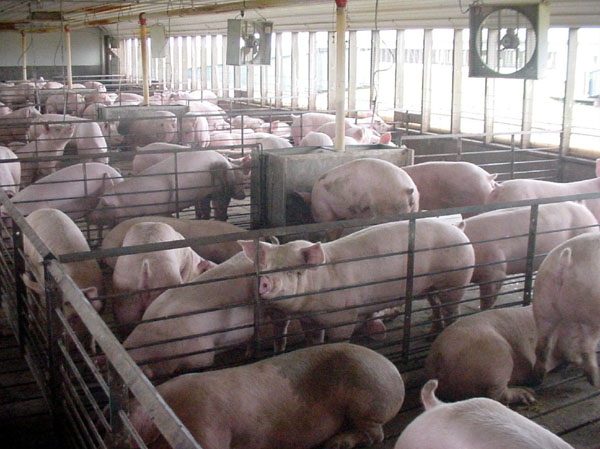When I decided to take classes that would allow me to conduct research on animals, I was prepared for some ethical struggles. I have raised and slaughtered chickens, but had no problems with it since I knew that I had given them good lives. However, I was concerned that research animal facilities would be like Concentrated Animal Feeding Operations (CAFOs aka factory farms), packing animals in efficiently, but with little regard for their welfare. During my classes, I was pleasant surprised. I saw that research animals were treated humanely, with much time, energy, and money spent to give them pleasant lives. However, the fact that they were treated so humanely confused me and led me to the following question: Why are research animals and livestock treated so differently?
To support our desire for meat, humans raise billions of chickens, cows, and pigs every year. In factory farms, many of these animals live in conditions that could kindly be described as inhumane. They have barely enough space to lie down, nothing to play with, food that amplifies weight gain but causes health problems, and constant exposure to their own excrement. They live short, brutal lives.

Clearly, these conditions are not uniformly practiced throughout our agricultural systems. However, the agribusiness industry continues to consolidate and strive for greater efficiency, meaning that more meat is raised and processed by fewer companies. Since CAFOs are one of the most efficient way to pack more animals into small spaces, they will likely continue to be a part of our national landscape.
In contrast, during my training, I learned about how to handle animals and treat them humanely. This means minimizing pain at ALL times and the provision of food, water, and clean bedding. Obviously, that doesn’t mean research animals won’t ever be in pain. They may be exposed to biohazards and carcinogens so we can learn about how these harmful substances work and how treat them successfully. They may get sick or die as a result of their exposures, or may need to be euthanized during the experiment.
To do any sort of research on animals, scientists must submit protocols that detail exactly what they will be doing with their animals, the expected outcomes, and how they will ensure humane treatment. This protocol gets approved by an institutional animal care and use committee (IUCAC), which makes sure it complies with federal guidelines.

Careful documentation is key. Otherwise, research privileges can be revoked. From: Wikimedia Commons
This disconnect between how research and farm animals are treated piqued my interest, so I looked into official regulations on animal welfare. The main difference that I found came directly from the USDA page on animal welfare:
“Farm Animals are regulated under the Animal Welfare Act (AWA) only when used in biomedical research, testing, teaching and exhibition. Farm animals used for food and fiber or for food and fiber research are not regulated under the AWA.”
I then looked into the Animal Welfare Act (AWA). I have outlined a few relevant provisions from the AWA below:
- Provide animals with adequate food, water, and veterinary care (including appropriate anesthetics, analgesics, or tranquilizers).
- Animal handlers must have adequate training so they can provide proper treatment and care. They must try to avoid causing distress or pain to the animal.
- Animals must have adequate exercise and psychological stimulation (for example, toys to play with, buddies, adequate space).
I still didn’t have an answer to my question, so I looked into philosophical arguments about animal treatment. Ethically speaking, how can we distinguish between the suffering of a human from that of a pig? Or a dog from a goat? From a strict animal rights standpoint, no. These creatures are all mammals, and thus their suffering is morally equivalent. From an animal welfare standpoint, there is a substantial difference between these mammals, mainly that animals lack moral agency. Animal welfare proponents argue that while animals are not equal to humans, they do deserve basic rights. These include: sufficient food and shelter, freedom to behave normally, and freedom from unnecessary injuries/disease, stress, and fear.
As I found out, American laws do not mandate these rights for animals that are raised for food. Thus, the distinguishing factor between a pig and a pig is whether it is being raised for research or for food.
Exempting farm animals from the AWA seems strange to me. We raise animals specifically for food. Maybe that make us feel less guilty about killing them. Without eating animals, we can’t live the way we want to live, so we just deal with the consequences. However, we specifically raise animals for research, too. We can’t live the way we want to live without animal research. Without it, many of our most outstanding medical achievements would not have occurred.
So why do we still feel so guilty about using research animals, so much so that they have specific protections that agricultural animals lack?
Is it because the agricultural industry exerts much control over legislators, blocking reform? They fought against increased cage sizes for chickens, and heavily lobbied to prevent any changes to their practices. Is it because we can dehumanize food animals, since we don’t have to see where they come from or how they are treated? Perhaps it’s because people worry that laboratory animals have been stolen, so they need special treatment. Maybe we anthropomorphize research animals, because they are tested with products that will be used on humans.
I don’t have any solid answers here. This question may be better addressed by politics, psychology, and philosophy than in the so-called “hard sciences”. What do you think?
References
- Diez-Gonzalez, Francisco, et al. “Grain feeding and the dissemination of acid-resistant Escherichia coli from cattle.” Science 281.5383 (1998): 1666-1668. DOI

